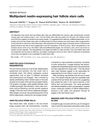TLDR Rat hair follicle stem cells can improve nerve repair and muscle function after injury.
This study investigated the use of rat hair follicle stem cells (rHFSCs) for regenerating sciatic nerve injuries in rats. The research demonstrated that rHFSCs are suitable for cell culture, proliferation, and differentiation. Rats were divided into three groups, and rHFSCs were injected into the site of nerve injury. After 8 weeks, assessments showed that the group receiving rHFSCs with epineurium had more effective nerve repair compared to other groups (P<0.05). The study concluded that rHFSCs improved axonal growth and functional recovery, suggesting their potential in enhancing nerve regeneration and muscle function after peripheral nerve injury. This research highlighted the promise of hair follicle stem cells as a source for stem cell therapy in nerve repair.
21 citations
,
November 2014 in “Cytotechnology” 57 citations
,
November 2011 in “The Journal of Dermatology” Hair follicle stem cells can help repair nerve injuries.
24 citations
,
March 2010 in “Journal of Cellular Biochemistry” Nestin-expressing blood vessels help skin transplants survive and heal.
36 citations
,
September 2009 in “Molecular Neurobiology” 121 citations
,
June 2009 in “Journal of Cellular Biochemistry” Human hair follicle stem cells can safely and effectively help nerve regeneration.
 37 citations
,
January 2009 in “The Journal of Dermatology”
37 citations
,
January 2009 in “The Journal of Dermatology” Hair follicle stem cells can turn into various cell types and help repair nerves.
319 citations
,
November 2005 in “Proceedings of the National Academy of Sciences” Hair follicle stem cells can help repair damaged nerves.
419 citations
,
March 2005 in “Proceedings of the National Academy of Sciences” Hair-follicle stem cells can become neurons.
212 citations
,
August 2004 in “Proceedings of the National Academy of Sciences” Hair follicle cells can create new blood vessels in the skin.
 17 citations
,
December 2010 in “Journal of Investigative Dermatology”
17 citations
,
December 2010 in “Journal of Investigative Dermatology” Flightless I protein affects hair growth, with low levels delaying it and high levels increasing hair length in rodents.


